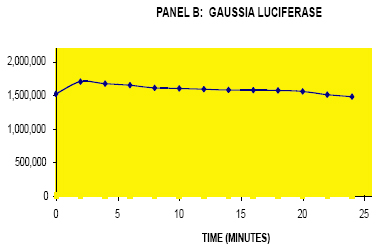|
Gaussia Luciferase Assay reagent (GAR-2, Catalog ·0090A) Stable version
Please call for special pricing on bulk reagent purchase. Product Description: The GAR-2Assay Kit includes an additional stabilizer component, as well as a modified assay buffer, which allows the use of the assay in high throughput format. With the standard protocol the light emission decays rapidly. The addition of stabilizer decreases the absolute value of light output slightly but confers excellent signal stability (approximately 10% decay in 1 hour, Figure 2A). This three component assay system provides the user with 2 options: (a) use the assay without stabilizer for enhanced light output or (b) use with the desired amount of stabilizer for enhanced stability.. Although the Gaussia luciferase signal obtained upon assaing samples with GAR-2 shows excellent stability making it suitable for HTS, we have recently developed a further improvement (GAR-2B)wherein the signal intentiy is much brighter than that obtained using the GAR-2 reagent and the signal stability is also much better. About Gaussia Luciferase: Gaussia Luciferase is a luciferase from the marine copepod Gaussia princeps (1,2). This luciferase, which does not require ATP, catalyzes the oxidation of the substrate coelenterazine in a reaction that produces light, and has considerable advantages over other luminescent reporter genes such as secretablity and a much brighter signal intensity iaddition to excellent stability of the bioluminescent signal (approximately 10% decay in an hour. The luminescence measured from the supernatant of cultured cells transfected with a plasmid expressing GLuc is proportional to the amount of enzyme produced, which in turn, reflects the level of transcription. Alternatively a cell lysate can be used for the assay. Although most of the activity is secreted, the high sensitivity of Gaussia luciferase allows measurements from the cell lysates as well. Figure 1: Photo-oxidation of coelenterazine catalyzed by Gaussia luciferase  Figure 2: Stability of the GLuc bioluminescent signal using the GAR-2 reagent. Panel A: With Stabilizer. Panel B: Without Stabilizer Using the GAR-2B version of the Gaussia luciferase assay reagent the bioluminescent signal remainsvery stable (Panel A). This reagent is useful for HTS applications in which a large number of samples need to be assayed. In the absence of the stabilizer, the signal.intensity is a little higher initially but decays faster than in the presence of stabilizer. Note: Data presented is average of triplicate determinations measured on a Turner TD2020 luminometer. 
Advantages:
Gaussia Luciferase Assay Protocol (GAR-2)  Kit Contents:
Assay Protocol: Make sure all buffers are at room temperature prior to assay
Intracellular Gaussia luciferase activity Lyse cells using our lysis buffer (Catalog no 5X CLR-01). Follow cell lysis protocol supplied with the product (see below). Assay as above using 5 ul to 10 ul of lysate NOTE: If you need to measure intracellular luciferase activity, lyse cells first using the cell-lysis buffer from Targeting Systems. (catalog no 5X CLR-01)
References:
Custom Reagents: We can provide custom formulations to fit your HTS application. Call our tech support team at 1-866-620-4018 or email us info@targetingsystems.com or targetingsystems@gmail.com Please check out our website www.targetingsystems.net for novel luciferase – based multiplexed assays which enable analysis of up to four promoter activities in the same group of transfected cells. |
